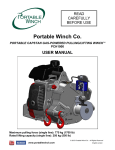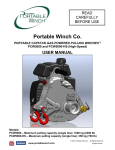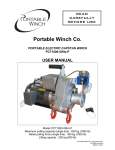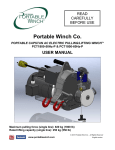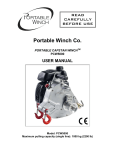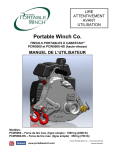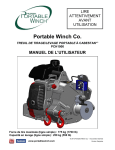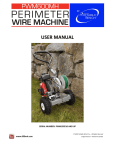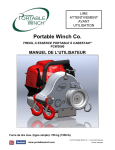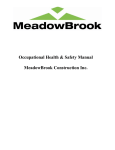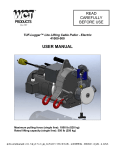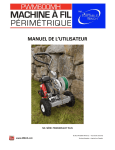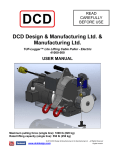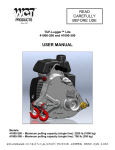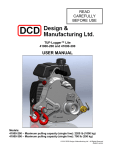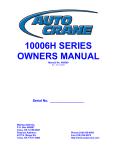Download Portable Winch Company
Transcript
SERIAL NUMBER: READ CAREFULLY BEFORE USE Portable Winch Co. PORTABLE CAPSTAN GAS-POWERED PULLING/LIFTING WINCHTM PCH1000 USER MANUAL Maximum pulling force (single line): 775 kg (1700 lb) Rated lifting capacity (single line): 250 kg (550 lb) © 2013 Portable Winch Co. - All Rights Reserved www.portablewinch.com English version Summary Introduction – p. 3 1.0 Safety guidelines – p. 3 1.1 Safety messages – p. 3 1.2 Labels – p. 4 1.3 Safety information – p. 5 2.0 Before first use – p. 6 2.1 Upon receiving the winch – p. 6 2.2 Is the engine ready to work? – p. 6 2.2.1 2.2.2 2.2.3 2.2.4 2.2.5 Engine oil – p. 6 Gas (petrol) – p. 6 Engine start-up – p. 7 Capstan drum – p. 7 Spark arrestor – p. 9 3.0 Winch usage – p. 9 3.1 Rope – p. 9 3.1.1 3.1.2 3.1.3 Rope type – p. 9 Rope usage – p. 10 Rope inspection and maintenance – p. 10 3.2 At the end of the rope – p. 13 3.2.1 Recommendations – p. 13 3.2.1.1 Pulling – p. 13 3.2.1.2 Lifting – Rope with buried eyed splice – p. 13 3.3 Winch anchors – p. 14 3.3.1 3.3.2 3.3.3 3.3.4 3.3.5 3.3.6 Using the polyester sling – p. 14 Using the hitch plate winch anchor for tow balls – p. 15 Using the winch support plate with square tubing – p. 15 Using the winch support plate with Heck-Pack system and winch support plate adaptor – p. 16 Using the tree/pole mount with anchor strap – p. 17 3.3.5.1 With the winch support plate – p. 17 3.3.5.2 With the vertical pull winch support – p. 18 Using the vertical pull winch support with square tubing – p. 19 3.4 Moving a load – p. 21 3.4.1 3.4.2 3.4.3 TM Installing the rope on the Portable Capstan Pulling/Lifting Winch Lifting – p. 23 3.4.2.1 Communications – p. 24 3.4.2.2 Load lifting charts – p. 25 3.4.2.3 Lifting operation – p. 26 3.4.2.4 Lowering a load – p. 26 3.4.2.5 Sending the rope back down – p. 28 Pulling – p. 28 3.4.3.1 Releasing the tension – p. 28 3.5 Oil Alert system – p. 29 4.0 Complementary information – p. 29 4.1 Accessories – p. 29 4.2 Serial number localization – p. 29 4.3 Warranty – p. 30 4.4 CE declaration of conformity – p. 31 4.5 Exploded view and parts list – p. 32 4.6 Technical data – p. 34 4.7 Noise emissions – p. 34 4.8 Inspection – p. 34 4.8.1 Initial inspection and test – p. 35 4.8.1.1 Engine – p. 35 4.8.1.2 Winch operation – p. 35 4.8.2 Daily inspection and test – p. 37 4.8.3 Frequent inspection (every 25 hours of operation) – p. 38 4.8.4 Periodic inspection (every 100 hours of operation) – p. 38 4.8.5 Winches not in regular service – p. 40 4.9 Manufacturer – p. 32 Schedule I: Periodic inspection Log Sheet (every 100 hours of operation) – p. 41 Schedule II: Inspecting the rope log sheet (every day) – p. 43 2 TM – p. 23 Introduction Portable Winch Co. wishes to thank you for purchasing a PCH1000 Portable Capstan Pulling/Lifting WinchTM. This manual was written to help you make the best use of your new winch and to use it in the most secure way. READ IT CAREFULLY BEFORE USING THE WINCH. For any problems or questions please refer to an authorized Portable Winch Co. dealer or contact us directly. 1.0 Safety guidelines The PCH1000 Portable Capstan Pulling/Lifting WinchTM is designed for lifting objects at angles up to vertical. It is fitted with a rope grabbing system that can maintain the load in position, and provide stop and go operation. THE ROPE GRABBING SYSTEM IS NOT DESIGNED TO STOP A FAST MOVING LOAD OR TO LIFT PEOPLE. The use of a lifting device implies serious risks of injuries, property damage or even death. DO NOT UNDERESTIMATE ITS POTENTIAL DANGER. WHEN LIFTING, NEVER GO OVER THE RATED LIFTING CAPACITY (250 kg (550 lb)) SINGLE LINE. WHEN LIFTING, NEVER BYPASS THE ROPE GRABBING SYSTEM. NEVER SHOCK LOAD THE SYSTEM. NEVER OPERATE WITHOUT PROPER TRAINING AND SUPERVISION. REMEMBER THE FIRST CAUSE OF ACCIDENT IS HUMAN ERROR. MAKE SURE EVERY PERSON HAS RECEIVED THE APPROPRIATE TRAINING FOR THE JOB. 1.1 Safety messages Your safety and the safety of others are very important. You will find important safety messages in this manual. READ THEM CAREFULLY. These security messages are warning you of potential injuries to either you or others. Every safety message is preceded by a warning symbol DANGER, WARNING or CAUTION. and one of the following terms: These indicator words mean: You WILL be MORTALLY or SEVERELY INJURED if you do not follow these instructions. You COULD be MORTALLY or SEVERELY INJURED if you do not follow these instructions. You COULD be INJURED if you do not follow these instructions. 3 1.2 Labels 1.2.1 Serial number and warning label The serial number and warning label is positioned on the right side of the winch housing. Read the meaning of all four icons (figure 1 to the right): 1. Read this instruction manual and Honda engine user’s manual prior to using the winch. 2. Only use low-stretch rope. Minimum diameter: 12 mm (1/2’’). Maximum diameter: 13 mm (1/2’’). 3. Never place your hands near the moving parts while the engine is running. 4. Never use the winch for lifting people. 1.2.1 Sound power level label The sound power level label is also positioned on the right side of the winch housing. The meaning of the icon in figure 1 to the right is: 1. The guaranteed sound power level is 105 dB. We recommend wearing hearing protection when using your Portable Capstan Pulling/Lifting WinchTM. 1.2.3 Rope ‘DANGER’ label The rope ‘DANGER’ label is positioned on the top of the winch housing. The meaning of the icon in figure 1 to the right is: 1. It is IMPERATIVE to use ONLY Portable Winch Co. double braided polyester rope 12-13 mm (1/2’’) with buried eyed splice and a minimal breaking strength of 3150 kg (6945 lb). 1.2.4 Rope installation label This label is positioned on the winch housing. It is a reminder of how to install the rope on the PCH1000. 4 1.2.5 Winch speed versus drum diameter label This label is positioned on the winch housing. The meaning is that if the 57 mm drum is installed, the maximum speed of the winch is 12 meters per minute and if the 85 mm drum is installed, the maximum speed is 18 meters per minute. 1.3 Safety information DO NOT LET CHILDREN USE THE PORTABLE CAPSTAN PULLING/LIFTING WINCHTM. KEEP CHILDREN AND ANIMALS AWAY FROM THE WORK AREA. NEVER LET SOMEONE WITHOUT TRAINING USE THE PORTABLE CAPSTAN PULLING/LIFTING WINCHTM. MAKE SURE THE USER KNOWS ABOUT THE SAFETY AND USAGE PROCEDURES AND HAS READ THIS MANUAL AND THE HONDA ENGINE USER MANUAL. THE OPERATOR SHOULD BE ABLE TO OPERATE A LIFTING DEVICE AND BE AWARE OF ALL ASPECTS OF SUCH OPERATIONS. HE SHOULD ALSO BE AWARE OF LOCAL REGULATION. INFORM ALL USERS OF THE SAFETY GUIDELINES AND USAGE PROCEDURES. FAMILIARIZE YOURSELF WITH THE PRODUCT AND THE SAFETY GUIDELINES BEFORE WORKING WITH THE WINCH. MAKE SURE THAT YOUR CLOTHES ARE NOT GOING TO GET CAUGHT INTO THE WINCH MOBILE PARTS. NEVER USE THE PORTABLE CAPSTAN PULLING/LIFTING WINCHTM TO LIFT PEOPLE. USE ONLY 12 MM TO 13 MM (1/2’’) DIAMETER DOUBLE BRAID PORTABLE WINCH CO. POLYESTER ROPE WITH THIS WINCH. NEVER LIFT OBJECTS OVERHEAD OF PEOPLE. ALWAYS USE THE PORTABLE CAPSTAN PULLING/LIFTING WINCHTM HORIZONTALLY, USING A PULLEY OR THE VERTICAL PULL WINCH SUPPORT TO REDIRECT THE ROPE VERTICALLY. THE EXHAUST GAS CONTAINS TOXIC CARBON MONOXIDE. NEVER RUN THE ENGINE IN A CLOSED AREA WITHOUT PROPER VENTILATION. REPLACE ANY SAFETY LABELS THAT ARE DAMAGED, ILLEGIBLE OR MISSING. 5 NEVER PUT YOUR HANDS ON THE CAPSTAN DRUM, THE ROPE GRABBING SYSTEM, THE ROPE ENTRY PULLEY OR NEAR THE ROPE GUIDE WHEN THE ENGINE IS RUNNING. ALWAYS KEEP BYSTANDERS OUTSIDE THE WORKING AREA. NEVER PULL ROLLING OBJECTS THAT MIGHT ROLL OUT OF YOUR CONTROL. NEVER TRY TO MOVE FIXED OR OBSTRUCTED LOADS. AVOID EXCESSIVE INCHING (E.G. GIVING SHORT PULSES TO THE MOTOR). ALWAYS INITIATE MOVEMENTS OF THE LOAD WITH THE LOWEST AVAILABLE SPEED. THE ROPE SHALL BE TIGHTENED AND SHALL NOT BE IN THE SLACK-CONDITION WHEN THE LOAD MOVEMENT BEGINS. SIDE-PULL OF LOAD IS NOT ALLOWED WITH THE PCH1000 PORTABLE CAPSTAN PULLING/LIFTING WINCHTM. KEEP IN MIND THAT YOUR SET-UP IS ONLY AS RESISTANT AS THE WEAKEST LINK. THIS IS WHY IT IS VERY IMPORTANT TO USE THE ADEQUATE ACCESSORIES IN ACCORDANCE WITH THE JOB TO BE DONE. IN THIS CASE (LIFTING), IT IS RECOMMENDED TO HAVE A 10 TO 1 SAFETY FACTOR FOR ALL ACCESSORIES. 2.0 Before first use 2.1 Upon receiving the winch Inspect the box to detect any apparent damage. If there is damage or missing parts, inform the carrier immediately. 2.2 Is the engine ready to work? 2.2.1 Engine oil Fill the Honda engine with a maximum of 0.25 litre of SAE 10W-30 API SJ oil. For special usage or conditions such as extreme weather, refer to the Honda engine user manual. Check the oil level on a horizontal surface. The oil level should be up to the edge of the opening. 2.2.2 Gas (petrol) Fill the gas (petrol) tank with UNLEADED PETROL. Do not use oil/gas (petrol) mixture; your Portable Capstan Pulling/Lifting WinchTM is equipped with a 4-stroke engine. Refer to the Honda engine user manual. 6 2.2.3 Engine start-up Refer to the Honda engine user manual for start-up instructions. FIRST USE: LET THE ENGINE RUN FIVE (5) MINUTES AT IDLE BEFORE FIRST PULL. The engine on-off switch is located on the winch housing, to the left of the handle (figure 1 to the right). Make sure to pull on the recoil starter in the axis of the rope outlet (figure 1 below). If you pull vertically (figure 2 below) the friction of the rope on the plastic cover might damage the rope and the cover. 2.2.4 Capstan drum Your Portable Capstan Pulling/Lifting WinchTM is equipped with the 57 mm (2-1/4") diameter capstan drum and the 117 mm (4-5/8’’) diameter safety lip. If you wish to change the drum for the 85 mm (3-3/8") drum (sold separately), you will also need to purchase and install the 127 mm (5’’) diameter safety lip. To do so, follow these simple steps: The tools required to change the drum are: A 4 mm (5/32") hex wrench (included with your winch). An 11 mm (7/16") wrench or adjustable wrench (not included). 1) Figure 1: Remove the two bolts holding the rope guide and then, remove the rope guide; 7 2) Figure 2: Remove the hex bolt holding the safety lip and drum using the 11 mm (7/16’’) wrench. Then, remove the washer, the safety lip and the spacer bushing; 3) Figure 3: Remove the drum from the shaft. If necessary, you may push it forward with two screwdrivers. Make sure that the shaft key stays in place. 4) Figure 4: Insert the 85 mm (3-3/8’’) drum on the winch shaft. Insert the washer, the safety lip and the spacer bushing on the hex bolt and insert this assembly in the hole of the shaft. Then, tighten the hex bolt with the 11 mm (7/16’’) wrench; 5) Figure 5: Insert the new rope guide in position and tighten it using the two (2) bolts. IMPORTANT: Make sure that the rope guide is not in contact with the capstan drum. 8 2.2.5 Spark arrestor In certain areas, it is forbidden to use a gas (petrol) engine without a spark arrestor. Check local regulations. An optional spark arrestor is available from Portable Winch Co. and/or Honda Power Products dealers. Installation: 1) Figure 1: Insert the spark arrestor into the exhaust tube. Make sure the holes are aligned; 2) Figure 2: Fasten lightly the metal screw provided with the appropriate screwdriver. Refer to the Honda engine user manual for the spark arrestor cleaning instructions. Portable Winch Co. part number: PCA-1151 Honda part number: 350-2M7-801 3.0 Winch usage MOST WINCHING SITUATIONS PRESENT POTENTIAL DANGERS! 3.1 Rope STAY OUT OF THE WINCH LINE’S PATH. 3.1.1 Rope type USE ONLY LOW STRETCH 12 OR 13 MM (1/2’’) DIAMETER PORTABLE WINCH CO. DOUBLE BRAIDED POLYESTER ROPE WITH A MINIMAL BREAKING POINT OF 3150 KG (6945 LB) WITH THIS WINCH. PLEASE CONTACT US FOR OTHER ROPE TYPE’S SUITABILITY. DO NOT USE 3-STRAND POLYPROPYLENE YELLOW ROPE! Polypropylene and polyethylene ropes are dangerous for winching because of their great elasticity and low melt point. Make sure the rope is not damaged and that it offers an adequate resistance to pull the load. 9 STRETCH EQUALS DANGER! A stretched rope can recoil and cause serious burns as the rope leaves your hand. All ropes stretch: a longer one more than a shorter one. The more you pull, the more it stretches. A stretched rope can also move the load in an unpredictable or dangerous way. A stretched rope can recoil and bring your hand towards the winch causing severe injuries. NEVER WRAP THE ROPE AROUND YOUR HAND. ALWAYS WEAR GLOVES. 3.1.2 Rope usage Use rope properly; do not abuse or shock load it. Observe recommended usage factors for bending and work loads. Keep ropes clean and eliminate abrasion whenever possible. 1) Working loads are the loads that a rope is subjected to in everyday activity. For lifting purposes we recommend a minimum safety factor of 7 (app. 15% of the rope minimum break strength) when the rope has a spliced termination. If the rope is knotted with a bowline, we recommend a safety factor of 10. 2) Any sharp bend in a rope under load decreases rope strength substantially and may cause permanent damage and failure. Sheave diameters should be 8 times the rope diameter. 3) Knots are known to reduce rope strength but they are a convenient way to accomplish rope attachment. The strength loss is a result of the sharp bends that occur in the knots. If you must use a knot, use the bowline or double bowline described in section 3.2.1.1. 4) Keep rope clean and as dry as possible. Grit and dirt will work its way inside the rope and degrade it rapidly. You can wash it in the washing machine and hang to dry. 5) Store the rope in a rope bag or in a pail. Coiling the rope will induce twists and knots. 6) Shock loads are a sudden change in tension from a relaxed state or low load to one of high load. Any sudden load that exceeds the work load by more than 10% is considered a shock load. The further an object falls, the greater the impact. Synthetic fibers have a memory and retain the effects of being overloaded and can fail at a later time even though loaded within the work load range. 3.1.3 Rope inspection and maintenance VISUALLY INSPECT YOUR ROPE BEFORE EACH USAGE. IF IT SHOWS ANY SIGN OF DETERIORATION (CUT STRANDS, EXCESSIVE ABRASION), REPLACE IT. IF YOUR ROPE IS DIRTY, WASH IT. DIRTY ROPES DETERIORATE FASTER AND CAUSE PREMATURE WEAR OF THE PARTS IN CONTACT WITH THE ROPE SUCH AS THE CAPSTAN DRUM AND ROPE GUIDE. Any rope that has been used for any period will show normal wear and tear. Some characteristics of a used rope will not reduce strength while others will. Below are the conditions that should be inspected on a regular basis. 10 Double braid ropes consist of a cover or jacket braided over a separately braided core. The strength of the double braid rope is shared between the cover and the core. Damage to the cover also usually affects the core and ultimately the strength of the rope. Rope inspection is done by running both hands over the entire length of the rope while turning it in order to see all around. It is a visual as well as a touch feeling process. TWIST: Every time you set the rope over the capstan drum you are twisting the rope. Depending on the length of the rope, and what percentage of the rope you use, you will sooner or later have a twisted rope with reduced capacity because the strands are not loaded evenly. You can un-twist the rope by spinning the rope to a free end. It is a good practice to reverse the rope – use both ends. In addition to help with the twist problem, the rope will also wear more evenly. GREY COLOR: This comes from aluminium residues from the friction on the capstan drum. Your hands will get dirty but this does not damage the rope. CUT STRANDS: A strand is made of one, two or more groups of twisted yarn. Braided ropes are typically 16-, 24- or 32-strand. They can get cut by abrasion against sharp edges or surfaces, or by cyclic tension wear. If three or more adjacent strands are cut, the rope shall be retired. 11 REDUCED VOLUME: The rope can get smaller because of abrasion and cyclic tension wear. If the rope volume is reduced by 50%, the rope shall be retired. For a 12 mm diameter rope, that means that a rope with a circumference of 19 mm shall be retired. Circumference measurement is easier than trying to measure the diameter. MELTED OR GLAZED FIBERS: The friction of the rope on the capstan drum generates heat. If the rope is subject to high friction heat for a long period – for example when the load is greater than the winch capacity – it can get damaged very quickly. If the rope shows fused fibers, visibly charred and melted fibers, yarns and/or strands, is extremely stiff and is unchanged by flexing, it shall be retired. DISCOLORATION/DEGRADATION: Chemical contamination can cause fused fibers, brittle fibers and stiffness. Retire the rope. INCONSISTENT DIAMETER: Shock loading or broken internal strands can cause flat areas or lumps and bumps on the rope. Retire the rope. IF YOU ARE IN DOUBT OF THE ROPE FITNESS – RETIRE THE ROPE! 12 3.2 At the end of the rope 3.2.1 Recommendations Since the Portable Capstan Pulling/Lifting WinchTM can be used for pulling and lifting, there are some guidelines to follow: 3.2.1.1 Pulling For pulling loads, you have to attach the load to the end of the rope. Even if a simple knot can do the job, we recommend the installation of a hook with the bowline knot (figure 1 on the right) because it can be easily undone if you need to change the hook. Moreover, it retains about 70% of the rope’s capacity while most knots will reduce it by more than 50%. Even better, the double bowline knot (figure 2 below) will keep about 75% of your rope’s capacity. 3.2.1.2 Lifting - Rope with buried eyed splice For lifting, you have to attach the load to the end of the rope. Even if you believe that a bowline knot could do the job, it is STRONGLY RECOMMENDED to use the Portable Winch Co. rope with buried eyed splice. The installation of a hook with a strong enough safety factor carabiner or shackle to the rope will help prevent any problems that might occur in case of knot failure. NOTE: Please, check with local authorities for safety regulations in your area. 13 3.3 Winch anchors The winch is anchored to a fixed point using the included polyester sling or with optional anchoring devices and the rope end is tied to the object you want to move. The load is moving towards the winch when you pull the rope. 3.3.1 Using the polyester sling (included with the winch) Go around the anchor point with the sling. Insert each end of the sling in one of the safety hooks located on the winch (figure 1 below). Position the winch in line with the load. When the winch is under tension, it will try to align itself with the load. The friction of the sling against the anchor point could prevent correct alignment. If that is the case, release the tension on the rope and position the sling on the anchor point so that the tension is equally distributed on both winch anchor hooks. DON’T DO THIS! WHEN YOU ANCHOR THE WINCH, MAKE SURE THAT YOU DO NOT DO A COMPLETE WRAP AROUND THE ANCHOR POINT (FIGURE 2 BELOW). THIS SET-UP WILL PREVENT PROPER ALIGNMENT OF THE WINCH WITH THE LOAD AND WILL PUT UNEVEN TENSION ON THE WINCH ANCHOR HOOKS. AVOID INSTALLING THE SLING ON SHARP EDGES THAT MIGHT DAMAGE IT. WHETHER YOU ARE USING A POST, A TREE OR A STUMP, ALWAYS INSTALL THE SLING NEAR THE ANCHOR’S BASE. USING A STUMP AS AN ANCHOR POINT MEANS PAYING SPECIAL ATTENTION IN ORDER TO PREVENT THE SLING FROM SLIPPING OVER IT. MAKE SURE THE ANCHOR POINT IS STRONG ENOUGH TO RESIST THE PULL WITHOUT BREAKING OR BEING DAMAGED. 14 3.3.2 Using the hitch plate winch anchor (PCA-1261) for tow balls up to 50 mm (2'') diameter 1) Figure 1: Push the safety hooks in the rectangular openings of the hitch plate. The rubber plate must be under the winch; 2) Figure 2: Start the winch engine; 3) Figure 3: Slide the plate on the ball hitch and pull the winch forward; 4) Figure 4: Wrap the rope around the drum and start winching. The winch will align itself automatically with the load. NOTE: Do not leave the winch on the hitch with the engine running; the resting position will cause the Oil AlertTM device to turn the Honda engine off (see section 3.5). USE THE HITCH PLATE ONLY WITH CATEGORY II BALL HITCH (1500 KG (3300 LB)) OR HIGHER. MAKE SURE THE ANCHORING VEHICLE’S HAND BRAKE IS ON AND WORKING PROPERLY. POSITION BLOCKS BEHIND THE WHEELS TO PREVENT ROLL BACK. 3.3.3 Using the winch support plate (PCA-1268) with square tubing 50 mm (2'') (PCA-1267) 1) Figure 1, no. 1: Slide the square tubing (PCA-1267) into the vehicle’s receiver and secure it with both the hitch pin and the ‘’R’’ pin; 2) Figure 1, no. 2: Slide the winch support plate (PCA-1268) onto the square tubing and secure it with both the hitch pin and the ‘’R’’ pin; Note: Its lateral movement can be adjusted by positioning the bolts into the square holes; 3) Figure 2: Attach the winch anchor hooks to the eye bolts; 15 4) Figure 2: Wrap the rope around the drum and start winching. The winch will align itself automatically with the load. IF YOU NEED TO PULL DOWNWARD, YOU WILL NEED TO INSTALL EITHER A PULLEY OR A ROLLER TO PREVENT DAMAGE TO THE WINCH SUPPORT PLATE. MAKE SURE THE ANCHORING VEHICLE’S HAND BRAKE IS ON AND WORKING PROPERLY. POSITION BLOCKS BEHIND THE WHEELS TO PREVENT ROLL BACK. 3.3.4 Using the winch support plate (PCA-1268) with Heck-Pack system for 50 mm European balls (PCA-1266) and winch support plate adaptor (PCA-1265) 1) Figure 1: Bolt the winch support plate adaptor (PCA-1265) onto the Heck-Pack system (PCA-1266) with the 4 bolts provided; 2) Figure 2: Insert the Heck-Pack on the ball and fasten it down with the lever; 3) Figure 2: Slide the winch support plate (PCA-1268) onto the square tubing of the winch support plate adaptor (PCA-1265) and secure it with both the hitch pin and the ‘’R’’ pin; Note: Its lateral movement can be adjusted by positioning the bolts into the square holes; 4) Attach the winch anchor hooks to the eye bolts (as shown in section 3.3.3); 5) Wrap the rope around the drum and start winching. The winch will align itself automatically with the load. 16 IF YOU NEED TO PULL DOWNWARD, YOU WILL NEED TO INSTALL EITHER A PULLEY OR A ROLLER TO PREVENT DAMAGE TO THE WINCH SUPPORT PLATE. MAKE SURE THE ANCHORING VEHICLE’S HAND BRAKE IS ON AND WORKING PROPERLY. POSITION BLOCKS BEHIND THE WHEELS TO PREVENT ROLL BACK. 3.3.5 Using the tree/pole mount with anchor strap (PCA-1263) The tree/pole mount is intended to use with either the winch support plate (PCA-1268) or the vertical pull winch support (PCA-1264). Therefore, you must first install the tree/pole mount. To do this, follow these steps: 1) Figure 1: Place the tree/pole mount at the base of the tree or pole. Insert the sling’s hook into the anchor point on the left; then feed the sling’s end through the ratchet system; 2) Figure 2: Slide the whole set-up upward to the desired height and remove the supplied wrench; 3) Figure 3: Tighten the sling with the wrench while making sure the rubber pads are properly positioned. The pads should offer maximum contact surface with the tree or pole. 3.3.5.1 With the winch support plate (PCA-1268) After the installation of the tree/pole mount (section 3.3.5), follow these steps: 1) Figure 1: Insert the winch support plate onto the square tubing of the tree/pole mount (PCA-1263) and fasten it down with the hitch pin and ‘’R’’ pin; Note: Its lateral movement can be adjusted by positioning the bolts into the square holes; 2) Figure 2: Attach the winch anchor hooks to the eye bolts of the winch support plate; 17 3) Figure 3: Wrap the rope around the drum and start winching. The winch will align itself automatically with the load. IF YOU NEED TO PULL DOWNWARD, YOU WILL NEED TO INSTALL EITHER A PULLEY OR A ROLLER TO PREVENT DAMAGE TO THE WINCH SUPPORT PLATE. AFTER PULLING FOR A FEW SECONDS WITH THE TREE/POLE MOUNT, RELEASE THE TENSION OFF THE PORTABLE CAPSTAN PULLING/LIFTING WINCHTM. CHECK THE SOLIDITY OF THE INSTALLATION AND TIGHTEN THE SLING AGAIN. 3.3.5.2 With the vertical pull winch support (PCA-1264) After the installation of the tree/pole mount (section 3.3.5), follow these steps: 1) Figure 1: Insert the vertical pull winch support onto the square tubing of the tree/pole mount (PCA-1263), align the holes and insert the pulley; 2) Figure 2: Tighten the nut with your fingers until it touches the support. Then secure it with the ‘’R’’ pin; 3) Figure 3: Attach the winch anchor hooks to the eye bolts of the vertical pull winch support; 4) Figure 4: Wrap the rope around the drum and align the vertical support pulley with the rope axe and start to pull; 18 IMPORTANT: DON’T GO OVER THE ROPE ENTRY PULLEY OF THE WINCH WITH THE ROPE (FIGURE 2 BELOW) AS IT WILL CREATE FRICTION AND WILL REDUCE LIFTING CAPACITY. GO UNDER THE ROPE ENTRY PULLEY (FIGURE 1 BELOW). IN THIS CASE, THE ROPE ENTRY PULLEY OF THE WINCH WILL NOT BE USED. IMPORTANT: AFTER PULLING FOR A FEW SECONDS, RELEASE THE TENSION AND CHECK THE SOLIDITY OF THE INSTALLATION AND TIGHTEN THE SLING OF THE TREE/POLE MOUNT AGAIN. 3.3.6 Using the vertical pull winch support (PCA-1264) with square tubing 50 mm (2'') (PCA-1267) ONLY USE VEHICLES EQUIPPED WITH CLASS III TOWING HITCHES. NEVER ATTEMPT TO LIFT MORE THAN THE RATED LIFTING CAPACITY OF 250 KG (550 LB). 19 PERFORM A TEST PULL WITH A LIGHT LOAD IN ORDER TO ASSES VEHICLE STABILITY AND EQUIPMENT INSTALLATION. 1) Figure 1: Slide the square tubing (PCA-1267) into the vehicle’s receiver and secure it with both the hitch pin and the ‘’R’’ pin; 2) Figure 2: Insert the vertical pull winch support onto the square tubing, align the holes and insert the pulley; 3) Figure 3: Tighten the nut with your fingers until it touches the support. Then reinforce it with the ‘’R’’ pin; 20 4) Figure 4: Attach the winch anchor hooks to the eye bolts of the vertical pull winch support; 5) Figure 5: Install rope from above in the redirection pulley by threading the rope end or by removing the bent hitch pin. Wrap the rope around the drum according to the load requirement as detailed in section 3.4.2.2 and align the vertical support pulley with the rope axe. MAKE SURE THE BENT HITCH PIN IS SECURED WITH THE R-PIN PRIOR TO PULLING. IMPORTANT: DON’T GO OVER THE ROPE ENTRY PULLEY OF THE WINCH WITH THE ROPE (FIGURE 2 BELOW) AS IT WILL CREATE FRICTION AND WILL REDUCE LIFTING CAPACITY. GO UNDER THE ROPE ENTRY PULLEY (FIGURE 1 BELOW). IN THIS CASE, THE ROPE ENTRY PULLEY OF THE WINCH WILL NOT BE USED. IMPORTANT: AFTER PULLING FOR A FEW SECONDS, RELEASE THE TENSION AND CHECK THE SOLIDITY OF THE INSTALLATION. 3.4 Moving a load USING COMMON SENSE WHILE MOVING A LOAD IS THE KEY TO A SECURE WINCH USAGE. The great variety of situations encountered when winching prevents us from providing specific instructions; however you need to consider the following points: CHECK WINCH POSITION, ROPE CONDITION, SOLIDITY OF THE ANCHOR POINT, KNOTS, CARABINERS OR SHACKLES IN ORDER TO PREVENT INJURIES OR MATERIAL DAMAGE. INSTALL THE ROPE IN SUCH A WAY THAT IT DOES NOT RUB AGAINST OTHER OBJECTS OR THROUGH AN OBSTRUCTION. GENERALLY, IF THE ROPE TOUCHES AN OBJECT, YOUR INSTALLATION IS INCORRECT. 21 NEVER PUT YOUR HANDS ON THE CAPSTAN DRUM, THE ROPE GRABBING SYSTEM, THE ROPE GUIDE OR THE ROPE ENTRY PULLEY WHEN THE ENGINE IS RUNNING. LOOK AT YOUR SET-UP TO MAKE SURE THAT THE WINCH ANCHORS AND THE ROPE ENTRY PULLEY ARE ALIGNED WITH THE ROPE. WHILE WINCHING, POSITION YOURSELF AWAY FROM THE WINCH IN ORDER TO SEE BOTH THE WINCH AND THE LOAD. PULL HORIZONTALLY ON THE ROPE. THE TENSION YOU EXERT ON THE ROPE WILL KEEP THE WINCH LEVELED. DO NOT OPERATE WITH THE WINCH TILTED OR THE OIL ALERT™ WILL KICK IN (SEE SECTION 3.5). DO NOT WRAP THE ROPE AROUND YOUR HANDS OR YOUR BODY! ALSO BEWARE OF THE ROPE ACCUMULATING NEXT TO YOU; MAKE SURE YOUR FEET DO NOT GET TANGLED IN IT. CAREFULLY WATCH THE CAPSTAN DRUM DURING THE OPERATION AND MAKE SURE THE ROPE DOES NOT CROSS OVER ON IT. IF IT HAPPENS, RELEASE THE TENSION ON THE ROPE AND STOP THE ENGINE WHILE UNDOING THE CROSS OVER. DO NOT PULL A LOAD DIRECTLY TOWARD THE WINCH IN A DOWNWARD SLOPE SINCE IT COULD SLIDE WITHOUT YOU BEING ABLE TO STOP IT. IN THAT SITUATION, USE A PULLEY AT THE BOTTOM OF THE HILL AND POSITION THE WINCH OUTSIDE OF THE LOAD’S PATH. 22 3.4.1 Installing the rope on the Portable Capstan Pulling/Lifting WinchTM NEVER PUT YOUR HANDS ON THE CAPSTAN DRUM OR THE ROPE ENTRY PULLEY WHEN THE WINCH IS RUNNING. 1) Figure 1: Open the rope grabbing system (no. 1) and lock in place with spring pin (no.2); 2) Start the engine and let it idle for 30 seconds to warm-up; 3) Figure 2: Run the rope OVER the rope keeper and the rope entry pulley (no. 1) and UNDER the drum (except when using vertical pull winch support (see section 3.3.5.2). Then, wrap the rope around the drum 3 or 4 turns (no. 2); 4) Figure 3: Insert the rope into rope grabbing system device by pulling the spring-loaded cam lever upwards (no. 1). This will give enough room to insert the rope. 5) Figure 4: Make sure the rope goes over the stainless steel knob (no. 1). Then, push the spring-loaded cam back against the rope which will automatically hold a load if the rope end is let go (no. 2). 6) Figure 5: As you pull the rope (no. 1), the throttle will engage and load will move. IMPORTANT: It is necessary to pull the rope HORIZONTALLY to get the load started. To stop load movement, stop pulling on rope (no. 2). 7) Stand about 1 m (3’) from the winch and pull gently and horizontally on the rope to get the slack until you feel the tension rising on the rope; 8) Look at your set-up to make sure that the winch anchor and the rope entry pulley are aligned with the rope; 9) Check that the rope does not rub against objects along the path; 10) Pull on the rope, the throttle will go up and the winching will start. 23 3.4.2 Lifting 3.4.2.1 Communications When using a signalperson, communication between the operator and the signalperson shall be maintained during all winch movements. If at any time communication is disrupted or not understood, the operator shall stop all winch movements until communication is re-established. Prior to signaling winch operations, all signalpersons shall be competent in the following areas: 1) Basic understanding of winch operations. 2) Standard hand signals described below whenever hand signals are used. 3) Standard voice signals described below whenever voice signals are used. Standard hand signals are: 1) HOIST or PAY IN: With forearm vertical, forefinger pointing up, move hand in small horizontal circle. 2) MOVE SLOWLY: Use one hand to give any motion signal and place other hand motionless together with the hand giving the motion signal. (Pay in slowly is example shown). 3) LOWER or PAY OUT: With arm extended downward, forefinger pointing down, move hand in small horizontal circle. 4) STOP: Arm extended, palm down, move arm back and forth horizontally. 5) EMERGENCY STOP: Both arms extended, palms down, move arms back and forth horizontally. 24 Standard voice signals shall be discussed and agreed upon by the operator and the signalperson prior to beginning lifting operations using voice signals. If special signals are required, they shall be agreed upon in advance by the winch operator and the signalperson. These signals should not be in conflict with the standard signals. 3.4.2.2 Load lifting charts BEFORE ATTEMPTING TO LIFT A LOAD, IT IS IMPERATIVE TO EVALUATE ITS APPROXIMATE WEIGHT. When lifting a load, you may figure the minimal number of wraps required on the capstan drum in order to move the load. Below are two charts in accordance with the capstan drum size used. These charts are designed to help figure out the number of wraps you need to lift a load and also allow its lowering. The friction on the capstan drum is relative to the size of the drum installed, the number of wraps and the load weight, therefore too many wraps may prevent a load to lower. IMPORTANT NOTE: IF THE MOTOR STALLS WHILE LIFTING A LOAD, YOU HAVE EXCEEDED THE RATED LIFTING CAPACITY. THEREFORE, YOU MUST LOWER THE LOAD TO RELEASE THE TENSION ON THE ROPE AND INSTALL A BLOCK AND TACKLE DEVICE TO INCREASE THE LIFTING CAPACITY BEFORE RESTARTING TO PULL. Number of wraps on the 57 mm (2-1/4’’) capstan drum Weight Kilograms From 1 Pounds To From To Never use only one wrap on the drum 2 3 1 kg 81 kg 80 kg 170 kg 2 lb 177 lb 176 lb 374 lb 4 171 kg 250 kg 375 lb 550 lb Number of wraps on the 85 mm (3-3/8’’) capstan drum Weight Kilograms From 1 2 3 Pounds To From To Never use only one wrap on the drum 1 kg 81 kg 80 kg 175 kg 2 lb 177 lb 176 lb 385 lb 25 3.4.2.3 Lifting operation ALWAYS WEAR GLOVES. To lift a load, you will need to decide which anchoring accessories you will use. Refer to section 3.3 Winch anchors to decide. KEEP IN MIND THAT YOUR SET-UP IS ONLY AS RESISTANT AS THE WEAKEST LINK. THIS IS WHY IT IS VERY IMPORTANT TO USE THE ADEQUATE ACCESSORIES IN ACCORDANCE WITH THE JOB TO BE DONE. IN THIS CASE (LIFTING), IT IS RECOMMENDED TO HAVE A 10 TO 1 SAFETY FACTOR FOR ALL ACCESSORIES. Refer to the charts in section 3.4.2.2 Load lifting charts for the correct drum size and number of wraps of rope to use 3.4.2.4 Lowering a load ALWAYS WEAR GLOVES. YOUR PORTABLE CAPSTAN PULLING/LIFTING WINCHTM IS EQUIPPED WITH A ROPE GRABBING SYSTEM. THIS SYSTEM IS NOT DESIGNED TO STOP FAST MOVING LOADS; DAMAGE CAN OCCUR TO THE ROPE AND/OR THE ROPE GRABBING SYSTEM WHEN SHOCK LOADED, AND POSSIBLY LEAD TO CATASTROPHIC FAILURE. DO NOT WRAP THE ROPE AROUND YOUR HANDS OR YOUR BODY! ALSO BEWARE OF THE ROPE ACCUMULATING NEXT TO YOU; MAKE SURE YOUR FEET DO NOT GET TANGLED IN IT. THE PORTABLE CAPSTAN PULLING/LIFTING WINCHTM IS NOT DESIGNED FOR LOWERING HEAVY LOADS OVER LONG DISTANCES. FRICTION OF THE ROPE ON THE CAPSTAN DRUM WILL GENERATE HEAT THAT COULD DETERIORATE OR EVEN MELT THE ROPE. YOU MAY WANT TO RUN SOME TESTS IN ORDER TO EXPERIMENT. YOU CAN ALSO USE PULLEY BLOCKS ON THE LOAD TO REDUCE FRICTION ON THE DRUM. AFTER EACH LOWERING OPERATION, IT IS IMPERATIVE TO CHECK ROPE CONDITION. NEVER GO OVER THE RATED LIFTING CAPACITY (250 KG (550 LB)) SINGLE LINE. NEVER BYPASS THE ROPE GRABBING SYSTEM. NEVER SHOCK LOAD THE SYSTEM. 26 BEWARE OF ROPE SNARLS WHILE LOWERING. IF ROPE GETS TANGLED, PULL ON ROPE WHILE ENGINE IS RUNNING UNTIL CLEARED. DO NOT TOUCH THE CAPSTAN DRUM IMMEDIATELY AFTER OPERATION AS IT WILL GET HOT AND BURN BARE SKIN. When you stop lifting with the Portable Capstan Pulling/Lifting WinchTM, the rope grabbing system engages, therefore, holds a load in position and keeps the rope under tension. To release it, follow these steps: 1. Figure 1, no. 1: Pull horizontally (and gently) on the pulling rope to engage the throttle, this will release the tension applied by the rope grabbing system on the pulling rope; 2. Figure 1, no. 2: Pull gently on the rubber handle of the rope attached to the rope grabbing system; this will disengage the system; DO NOT COMPLETELY DISENGAGE THE ROPE GRABBING SYSTEM, IN CASE OF EMERGENCY, SIMPLY LET THE RUBBER HANDLE GO, THE SYSTEM WILL RE-ENGAGE. NEVER LET THE PULLING ROPE SLIDE SUDDENLY IF A LOAD IS SUSPENDED. 3. Figure 1, no. 3: Slowly payout the pulling rope (push it towards the winch if necessary this may occur if you have four wraps of rope on the drum and a light load) while keeping the rope grabbing system slightly open; 4. Figure 1, no. 4: Release the tension applied to the rubber handle, this will re-engage the rope grabbing system. You can now let go the pulling rope and grab it further; 5. Repeat steps 1 to 4 until the load is at desired position or completely lowered; 6. Once at desired position, let the rubber handle go, this will re-engage the system (if needed); 7. If needed, stop the engine with the on/off switch. 27 3.4.2.5 Sending the rope back down After lifting objects, you may want to send the rope back down. Since there is no reverse on the winch and friction is in cause, simply disengage the rope grabbing system, remove the rope from the capstan drum to eliminate friction and let the rope back down. If the rope does not come down, you may have to attach a small rope to it (prior to lifting) in order to pull it back down. 3.4.3 Pulling To pull a load, follow the steps found in section 3.4.1. However, when pulling a load on the ground that does not risk falling or rolling back, you may want to disengage the rope grabbing system. If you do not and the load get stuck, you may have trouble getting some slack since the rope will already be stretched to its maximum and the rope grabbing system will be very hard to disengage. IF THERE IS ANY RISK THE LOAD MAY FALL OR ROLL BACK, DO NOT COMPLETELY DISENGAGE THE ROPE GRABBING SYSTEM. Using the winch without the rope grabbing system allows you to release the tension and benefit from the elasticity of the rope to restart pulling and let the engine reach its maximum revolution (RPM). To disengage the rope grabbing system, open the spring-loaded cam upwards and let it rest on the frame of the rope grabbing system (figure 1, no.1). To re-engage it, lift it upward again and bring it back towards the pulling rope (figure 1, no.2). 3.4.3.1 Releasing the tension ALWAYS WEAR GLOVES. STRETCH EQUALS DANGER! DO NOT WRAP THE ROPE AROUND YOUR HANDS OR YOUR BODY! ALSO BEWARE OF THE ROPE ACCUMULATING NEXT TO YOU; MAKE SURE YOUR FEET DO NOT GET TANGLED IN IT. 28 3.4.3.1.1 When pulling with the rope grabbing system engaged If the rope grabbing system is used, when you stop pulling with the Portable Capstan Pulling/Lifting WinchTM, the rope grabbing system engages, therefore, applies pressure on the rope and keeps it under tension. To release it, follow steps 1 to 7 of section 3.4.2.4). 3.4.3.1.2 When pulling with the rope grabbing system disengaged If the rope grabbing system is not used, when you stop pulling with the Portable Capstan Pulling/Lifting WinchTM, you simply have to release tension gradually to lower the winch gently to the ground. 3.5 Oil AlertTM system The GXH-50 Honda engine is equipped with an Oil AlertTM system that automatically turns off the ignition when the oil level goes below a safe level. The Oil AlertTM system also turns off the ignition when the winch is operating at an angle greater than 20 degrees (± 4 degrees). Make sure that your set-up keeps the winch at a relatively horizontal level while winching and idling. 4.0 Complementary information 4.1 Accessories A complete line of accessories is available. Simply visit www.portablewinch.com. 4.2 Serial number localization The winch serial number is indicated on the serial number and warning label located on the right side of the winch housing and is also engraved on the cover of the winch, to the left of the capstan drum. 29 4.3 Warranty Portable Winch Co. products are warranted against defects in materials and workmanship while owned by the ''original purchaser''. The ''original purchaser'' is defined as the party or entity which purchases the winch and/or accessories from an authorized Portable Winch Co. retailer as shown by the original invoice. The warranty ownership is transferable, provided the end-user has a copy of the original purchaser’s invoice. This warranty does not apply to ''wear parts'' defined as being in contact with the rope while winching. The PCH1000 Portable Capstan Pulling/Lifting WinchTM is covered as follow: Winch components: o Private use: Two (2) year warranty (service by Portable Winch Co. and/or its retailers); o Commercial use: One (1) year warranty (service by Portable Winch Co. and/or its retailers); Engine: The Honda engine is warranted by Honda Motor Corporation and the duration varies according to country and usage. All Honda service centers can repair the winch engine under warranty. Hang on to your proof of purchase (invoice with serial number). It will be used to establish the beginning of the warranty period. Portable Winch Co. will replace or repair, at its option, any defective product. All other Portable WinchTM accessories are covered by a complete one (1) year warranty. Please refer to the Portable Winch Co. warranty policies on www.portablewinch.com if you have any questions. Extend your warranty for free We would like to thank you for your purchase. By doing so we would like to offer you ONE (1) EXTRA YEAR WARRANTY for FREE! It's simple, simply register your winch on www.portablewinch.com or by phone at 1-888-388-PULL (7855) or +1 819 563-2193. 30 4.4 CE Declaration of conformity DECLARATION OF CONFORMITY We of PORTABLE WINCH CO. 1170 Thomas-Tremblay St. Sherbrooke, QC J1G 5G5 CANADA Tel: +1 819 563-2193 www.portablewinch.com Declare that the product Portable Capstan Pulling/Lifting Winch Model PCH1000 Serial numbers 1001 and higher For intended purpose Pulling and lifting objects at angles up to vertical Conforms to the dispositions of Machinery Directive 2006/42/EC And also conforms to the disposition of - 2004/108/EC Electromagnetic Compatibility Directive Mr. Gerold Vonblon, Landstrasse 28, A-6714 Nuziders Is authorized to compile the technical file. Signed by: Name: Position: Pierre Roy Managing Director Done at Sherbrooke, QC, Canada On April 18th, 2012. 31 4.5 Exploded view and parts list 32 ITEM NO. PART NUMBER DESCRIPTION QTY 1 31-0024 BHCS 1/4-20 X 1 - SS 6 2 31-0010 HCS 1/2-13 X 6 GR5 - ZN 1 3 35-0004 FLAT WASHER 1/2 - ZN 4 4 10-0098 BUSHING FOR SAFETY HOOK 2 5 PCA-1281 SAFETY HOOK 3/4 TON 2 6 31-0019 HCS 3/8-24 X 1 - ZN 1 7 35-0006 FLAT WASHER 1/4 - ZN 3 8 70-0023 ON/OFF SWITCH WITH SUPPORT PLATE FOR GXH-50 ENGINE 1 9 39-0007 METAL SCREW NO. 10 X 1/2 (PAN HEAD. SQ. DR.) 4 10 10-0094 WINCH HANDLE 1 11 10-0171 VINYL GRIP PCH1000 1 12 33-0005 NYLON LOCKNUT 1/2-13 ZN 1 THROTTLE CABLE ASSEMBLY 1 13 14 10-0059 THROTTLE CABLE HOUSING SUPPORT PLATE 1 15 39-0005 THROTTLE SPRING DWX-03 OD - 8.5 - SS 1 16 10-0058 THROTTLE SPRING ATTACHEMENT PLATE 1 17 41-0001 CABLE HOLDER 1 18 32-0002 HEX FLANGE SERRATED BOLT M6-1 X 12 MM - ZP 6 19 10-0041 GUARD PLATE PCH1000 1 20 10-0103 ROPE KEEPER 1 21 10-0101 ROPE ENTRY PULLEY 1 22 10-0119 SHOULDER BOLT 5/8 X 1-1/2 - ZN 2 23 10-0100 ROPE GUIDE FOR CAPSTAN DRUM 57 MM 1 24 31-0025 BHCS 1/4-20 X 3/4 - SS 2 25 43-0013 SHAFT KEY FOR CAPSTAN DRUMS 57 MM & 85 MM 1 26 10-0096 CAPSTAN DRUM 57 MM 1 27 10-0043 SPACER FOR SAFETY LIP 1 28 10-0042 SAFETY LIP FOR CAPSTAN DRUM 57 MM 1 29 10-0102 DRUM RETAINING WASHER 1 30 31-0011 HCS 1/4-20 X 2-1/4 - GR5 - ZN 1 31 70-0008 RGS - PIVOTING ASSEMBLY 1 32 31-0033 SHCS 5/16-18 X 1-3/4 - SS 1 33 39-0014 PULL PIN 1/4-20 1 34 70-0007 RGS - ATTACHMENT ASSEMBLY 1 35 10-0044 SAFETY LIP FOR CAPSTAN DRUM 85 MM 1 36 10-0001 CAPSTAN DRUM 85 MM 1 37 31-0025 BHCS 1/4-20 X 3/4 - SS 2 38 10-0106 ROPE GUIDE FOR CAPSTAN DRUM 85 MM 1 39 44-0001 LABEL - PW - UNIVERSAL TO ENGRAVE SERIAL NO. & SPECS 1 40 44-0029 LABEL - 105 dB 1 33 41 44-0022 LABEL - ROPE DANGER 1 42 44-0026 LABEL - ROPE INSTALLATION PCH1000 - PCT1800 1 43 44-0033 LABEL - SPECS SPEED VS DRUM DIAMETER PCH1000 1 44 45-0036 HOUR METER 1 4.6 Technical data Engine: 4-stroke Honda GXH-50cc Maximum pulling force (single line): o 57 mm drum: 775 kg (1700 lb) o 85 mm drum: 540 kg (1190 lb) Rated lifting capacity (single line): o 57 mm drum: 250 kg (550 lb) o 85 mm drum: 175 kg (385 lb) Speed: o 57 mm drum: 12 m/min (40 ft/min) o 85 mm drum: 18 m/min (60 ft/min) Installed Capstan drum: 57 mm (2-1/4’’) diameter o Up to 4 wraps of 12-13 mm (1/2’’) rope Gear box: Aluminum alloy; Gear ratio 110:1 Unit weight: 19 kg (42 lb) Clutch: Centrifugal Rope grabbing system (can be disabled) Dimensions (overall): Length 50,5 cm x Width 36,6 cm x Height 36,6 cm (19-7/8’’ x 14-3/8’’ x 14-3/8’’) Rope: Double braided polyester (not included) – Unlimited rope length o Minimum diameter: 12 mm (1/2’’) o Maximum diameter: 13 mm (1/2’’) o Recommended rope with buried eye splice 4.7 Noise emissions Here are the different noise emissions of the Portable Capstan Pulling/Lifting WinchTM: Sound pressure level at operator position – LPA (measured) o Engine idling: 73 dBA o Full throttle: 89 dBA Sound power level – LWA (measured) o Engine idling: 85 dBA o Full throttle: 102 dBA Guaranteed sound power level – LWA : 105 dBA 4.8 Inspection This section applies to winches used for lifting. The term inspect implies that any minor repair, tightening, part replacement, cleaning, adjustment, etc, that can be performed during the inspection procedure is done. The procedures below are intended to provide a guide to the end-user to help maintain compliance with ASME/ANSI Standard B30.7-201 and ISO Standard 14492-1:2006. Local authorities may require other periodic test procedures. 34 4.8.1 Initial inspection and test When the new or factory refurbished winch is first put in service, perform the following: 4.8.1.1 Engine 1) 2) 3) 4) Check oil level (see Honda Owner’s Manual); Check air filter (see Honda Owner’s Manual); Check fuel level (see Honda Owner’s Manual); Test On/Off switch by starting the engine with switch on, and turning it off. If the engine fails to turn off, it can be shut down by closing the choke. 4.8.1.2 Winch operation 4.8.1.2.1 Test throttle adjustment Without rope on the drum: 1) Pull on plate and confirm that the maximum course is reached (picture #1); 2) Observe drum rotating under full throttle; 3) Release plate and confirm the minimum course is reached by spring return action (picture #2); 4) Observe drum not rotating when engine is idling; 5) If there are any adjustments to be made, perform the adjustments and re-test; 6) Listen for any unusual noise. 1. 2. 35 4.8.1.2.2 Test rope grabbing system 1) With the rope grabbing system (brake) engaged: Attach winch to suitable anchor and attach rope to fixed point at some distance directly in front of the winch (picture below); 2) Pull rope until rope is under tension and let go of the rope; 3) Observe that the tension is maintained by the rope grabbing system. 4.8.1.2.3 Test winch anchoring 1) With the rope grabbing system (brake) disengaged (see section 3.4.3): Test anchor by exerting twice the maximum pulling force of the winch, using a block attached to a fixed point and attaching the rope end to the anchor point (picture below). DO NOT ANCHOR THE ROPE BACK TO THE WINCH 36 2) If the anchor is moving or show any sign of potentially moving, find a new anchor point and perform the test again. 3) IMPORTANT: Document this initial inspection as the first Periodic Inspection in the log at the end of this document. 4.8.2 Daily inspection and test This has to be performed every day (written records are not necessary): 1) Inspect rope grabbing system (see picture) for any sign of wear or loose parts. 2) Check engine oil and air filter. 3) Without load, test the winch controls by pulling the rope end. a. Observe that the throttle is rising to its maximum and the drum is turning normally; b. Listen for abnormal noises; c. Release the rope and observe that the throttle is going to idle by spring return and the drum stops turning when idling. 4) Test the operation of the on/off switch. 5) Check that the rope entry pulley (brass pulley) is rotating freely; if not clean and lubricate. Replace pulley if any flat spots are present. 6) Inspect the rope for excessive wear, damage or distortion (see rope inspection and maintenance section 3.1.3). 7) Inspect slings and straps used to anchor the winch for cuts and abrasion. 8) If using a new anchor point: a. With the rope grabbing system (brake) disengaged (see section 3.4.3): Test anchor by exerting twice the maximum pulling force of the winch, using a block attached to a fixed point and attaching the rope end to the anchor point. 37 b. If the anchor is moving or show any sign of potentially moving, find a new anchor point and perform the test again. DO NOT ANCHOR THE ROPE BACK TO THE WINCH 4.8.3 Frequent inspection (every 25 hours of operation) This has to be performed every 25 hours of operation (written records are not necessary): 1) Inspect control mechanism for any sign of wear or loose parts. 2) Clean engine air filter. Service more frequently when operating in dusty areas. 3) Change engine oil. 4) Without load, test the winch controls by pulling the rope end. a. Observe that the throttle is rising to its maximum and the drum is turning normally; b. Listen for abnormal noises; c. Release the rope and observe that the throttle is going to idle by spring return and the drum stops turning when idling. 5) Test the operation of the on/off switch. 6) Inspect the rope for excessive wear, damage or distortion (see rope inspection and maintenance section 3.1.3). 7) Inspect all rope end securement fittings (hooks, shackles, carabiners, etc.) Look for cracks, shock marks, deformation, corrosion, pitting, gates functionality, etc. Do not hesitate to retire part when in doubt. 8) Inspect all warning and instruction labels for deterioration. 9) Ensure the instruction manual is present and legible. 10) Look for leaks around gearbox. If any found, verify gearbox oil level. 11) Remove capstan drum and clean any debris that may have accumulated around the shaft and near the oil seal. Apply some oil on the shaft before re-assembly. 12) When in doubt a qualified person should determine if the condition requires further repairs or the equipment to be taken out of service; alternately the equipment should be sent to an authorized Portable Winch service center for evaluation. 4.8.4 Periodic inspection (every 100 hours of operation) This has to be performed every 100 hours of operation. In addition to the items below, perform all items from the Frequent Inspection (section 4.8.3 above). Write the results of this Periodic Inspection in the log table at the end of the manual. 4.8.4.1 Gearbox 1) Look for leaks. If any found, check gearbox oil level. 2) Look for any loose screws or bolts, and particularly look at bolt and locknut holding the safety hooks. There should be at least one visible thread on the bolt beyond the locknut. 38 3) Inspect anchor hooks for cracks and deformation. Check that the safety clasps are functional. 4) Check end play by pulling and pushing the capstan drum. A small movement is normal, more than 0.5 mm indicates the drum retaining screw could be loose or the washer damaged. 5) Check drum keyway by turning the drum back and forth. A small movement is acceptable and indicates proper gear backlash. Large movement may indicated wear of the keyway; if so remove end screw and inspect. 6) Check that rope entry pulley (brass pulley) is rotating freely; if not clean and lubricate. Replace pulley if any flat spots are present. 7) Rope Grabbing System: Check that plate is pivoting freely and that there is no excessive wear on the pivot surfaces. Check if pivot bolt is tight. 8) Look at casting for cracks, particularly in the anchoring region. 9) Remove engine from the gearbox by removing the 6 bolts (see picture below). a. Inspect clutch rotor (engine side) for: i. Cracks; ii. Loose screws; iii. Uneven wear or other damage. b. Inspect clutch drum (gearbox side) for: i. Wear: minimum thickness: 2 mm (0.080"); ii. Tightness: no noticeable axial movement; iii. Bearing condition: turns evenly and smoothly by hand. 39 4.8.4.2 Engine 1) 2) 3) 4) 5) Clean/adjust spark plug; Check/adjust idle speed; Check/adjust valve clearance; Clean fuel tank and filter; Clean spark arrestor if equipped. a. NOTE: These items should be serviced by your Honda servicing dealer, unless you have the proper tools and are mechanically proficient. Refer to the Honda shop manual for service procedures. 4.8.4.3 General winch condition Make an assessment of the general winch condition in a clear manner such as Excellent, Good, Needs Repairs, Requires Further Evaluation, etc. 4.8.5 Winches not in regular service 1) A winch which has not been used for more than one month, but less than six months, shall be given a Frequent Inspection before being put in service. 2) A winch which has not been used for more than six months shall be given a periodic inspection prior to being put in service. 4.9 Manufacturer The PCH1000 Portable Capstan Pulling/Lifting WinchTM is manufactured by: Portable Winch Co. 1170, Thomas-Tremblay Street Sherbrooke, Quebec, J1G 5G5 CANADA Phone: +1 819 563-2193 Toll free (Canada & USA): 1-888-388-PULL (7855) Fax: +1 514 227-5196 - Email: [email protected] - www.portablewinch.com 40 Schedule I. Periodic inspection log sheet (every 100 hours of operation) WINCH SERIAL NUMBER: (over 600 hours, print more of these pages at www.portablewinch.com) DATE HOUR METER READING INITIAL INSPECTION #1 #2 #3 #4 #5 #6 YES / NO GEARBOX Warning labels present and legible? Any leaks found? Gearbox oil level is OK All screws and bolts are tight Anchor hooks - no cracks, clasp is working Shaft end-play less than 0.5 mm (0.020'') Drum keyway is tight Capstan shaft & seal area are clean Rope entry pulley (brass pulley) rotating, no flat section Cracks in housing found? ROPE GRABBING SYSTEM/WINCH CONTROLS Main plate pivots freely Pivot bolt is tight No excessive wear on pivoting parts Throttle control operational Clutch rotor is tight, no cracks or uneven wear Clutch drum is tight, turns freely, wall is >2 mm ENGINE Spark plug is clean with proper gap Idle speed is adjusted Valve clearance within specs Fuel tank/filter are clean Spark arrestor is clean Oil is new and level is good Air filter is clean 41 ROPES, HOOKS, LINKS Rope is in good condition whole length Rope termination is not damaged Hooks are in good condition Links (shackles, carabiners, etc.) are good TEST On/Off switch is operational Drum is not rotating at idle Drum is rotating at full throttle Throttle can reach maximum course Rope grabbing system (brake) is operational No unusual noises are heard GENERAL WINCH CONDITION Excellent Good Needs repairs Requires further evaluation Other NOTES 42 Schedule II. Inspecting the rope log sheet (every day) As specified in section 3.1.3 Rope inspection and maintenance, the rope and its termination should be inspected daily to its full length to detect wear. This page allows you to collect information. It is indicative and may be reproduced and used for daily verification of your rope. WINCHING ROPE DIAMETER : TERMINATION : LENGTH : MANUFACTURER : FIBRES : COMMISSIONING DATE : CONSTRUCTION : Daily verification DATE INSPECTION OR INCIDENT NOTES AND SIGNATURE 1 2 3 4 5 6 7 8 9 10 11 12 13 14 15 16 43 17 18 19 20 21 22 23 24 25 26 27 28 29 30 31 32 33 34 35 36 37 38 39 40 41 42 43 44 44












































